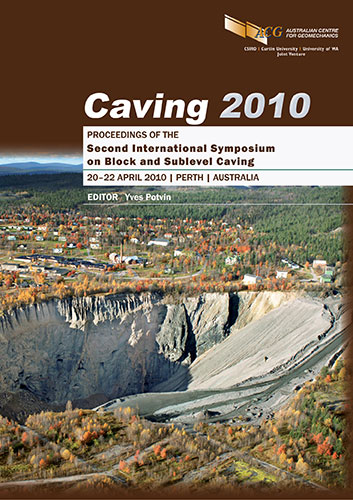New approach for rapid preparation of block caving mines

|
Authors: Encina, V; Méndez, D; Caballero, C; Osorio, H |
DOI https://doi.org/10.36487/ACG_rep/1002_18_Encina
Cite As:
Encina, V, Méndez, D, Caballero, C & Osorio, H 2010, 'New approach for rapid preparation of block caving mines', in Y Potvin (ed.), Caving 2010: Proceedings of the Second International Symposium on Block and Sublevel Caving, Australian Centre for Geomechanics, Perth, pp. 279-287, https://doi.org/10.36487/ACG_rep/1002_18_Encina
Abstract:
Block and panel caving is one of the most suitable methods for exploitation of large massive ore bodies where a high rate of extraction is required. However, many authors have studied the rate of extraction and concluded that it may be limited by the ability to prepare mines at high rates. Different approaches, to increasing the rate of extraction, tend towards the introduction of some kind of continuous draw and materials handling on production levels, which apparently are close to reaching a practical solution. However, corresponding studies to match the rate of mine preparation to high extraction rate operations have not been discussed or published to any great depth. This paper describes some layouts and constructive techniques compatible with rapid mine preparation demand. A significant reduction of time in mine preparation, in both underground drifting and construction is expected as a consequence of the introduction of non-blasting excavation methods and using pre-cast concrete modules to build up underground mine construction. The main advantage of non-blasting drifting, is the predictability of finishing underground drifts, such that it is possible to standardise all the components of single underground mine constructions (i.e. drawpoint, dump points). The solution requires adapting and developing both new equipment and new layouts, because neither standard full face boring machines nor current layouts for conventional block/panel caving are suitable to high speed development of caving levels. The layouts discussed focus on conventional load–haul–dump units (LHD) and on mechanised continuous drawing system (MCDS) arrangements. In each case, the general arrangement presented has been developed by JRI Ingeniería S.A as part of its technological innovation policy. Finally, an evaluation of the impact upon scheduling and costs, are presented in comparison with conventional methods. New approaches are also mentioned about other issues such as logistics and commissioning, with new actors in the business, which may produce additional benefits for project and operation management.
References:
Departamento de Construcción y Estructuras (2001) Muros colados y otros métodos constructivos, Faculty of Engineering of University of Buenos Aires, August, Buenos Aires, Argentina.
Encina, V., Baez, F., Geister, F. and Steinberg, J. (2008) Mechanized continuous drawing system: A technical answer to increase production capacity for large block caving mines, in Proceedings 5th International Conference on Mass Mining, MassMin 2008, H. Schunnesson and E. Nordlund (eds), 9–11 June 2008, Luleå, Sweden, Luleå University of Technology Press, pp. 553–562.
Pesce, J. and Ovalle, A. (2004) Production capacity of a mass caving, in Proceedings MassMin 2004, A. Karzulovic and M. Alvaro (eds), 22–25 August, Santiago, Chile, Instituto de Ingenieros de Chile, Santiago, pp. 75–78.
van As, A., Jeffrey, R., Chacón E. and Barrera V. (2004) Preconditioning by hydraulic fracturing for block caving in a moderately stressed naturally fractured orebody, in Proceedings MassMin 2004, A. Karzulovic and M. Alvaro (eds), 22–25 August, Santiago, Chile, Instituto de Ingenieros de Chile, Santiago, pp. 535–541.
© Copyright 2026, Australian Centre for Geomechanics (ACG), The University of Western Australia. All rights reserved.
View copyright/legal information
Please direct any queries or error reports to repository-acg@uwa.edu.au
View copyright/legal information
Please direct any queries or error reports to repository-acg@uwa.edu.au